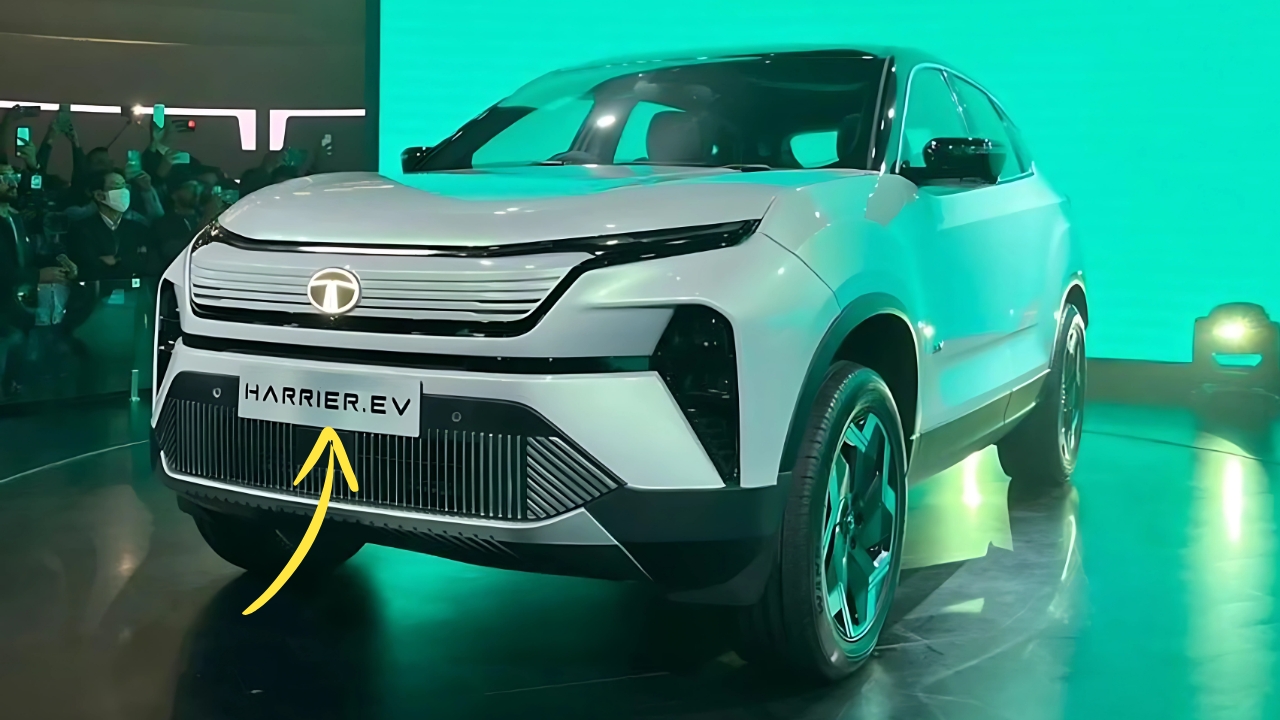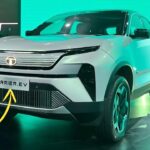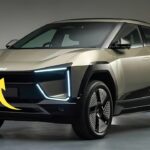Tata Harrier EV: In the rapidly evolving landscape of electric mobility, Tata Motors has emerged as a pioneering force within the Indian automotive sector.
Building upon the success of its combustion-powered namesake, the Tata Harrier EV represents a significant milestone in the company’s electrification journey.
Unveiled in early 2025, this all-electric SUV embodies Tata’s commitment to sustainable transportation while addressing the unique challenges and requirements of the Indian market.
Tata Harrier EV: Design Evolution: Electrified Identity
The Harrier EV maintains the distinctive silhouette of its ICE counterpart while introducing subtle yet meaningful design adaptations that signal its electric powertrain.
The most noticeable change appears at the front, where the traditional grille has been replaced by a sleek, body-colored panel featuring illuminated Tata insignia – a design signature now common across the company’s electric lineup.
Aerodynamic efficiency, crucial for maximizing range, influenced several design elements. The redesigned front bumper channels air more effectively around the vehicle, while flush door handles and specially designed 19-inch aero-optimized wheels reduce turbulence during highway cruising.
Despite these functional considerations, the Harrier EV retains the commanding presence that made the original model successful, with its raised hood line and muscular haunches conveying strength and stability.
The exterior color palette introduces four new options exclusive to the electric variant, including the striking Aurora Green that has become something of a signature for Tata’s EV models.
LED lighting features prominently throughout, with a distinctive light bar connecting the headlamps and sequential turn signals adding a touch of technological sophistication.
Interior Space: Reimagined Architecture
Inside, the benefits of the dedicated EV architecture become immediately apparent. The absence of a transmission tunnel creates a genuinely flat floor, enhancing rear passenger comfort and enabling a novel center console design that emphasizes storage and versatility.
Sustainable materials feature prominently throughout the cabin, with recycled fabrics, responsibly sourced wood trim, and eco-friendly alternatives to traditional leather upholstery.
The dashboard adopts a minimalist approach centered around dual 12.3-inch displays – one serving as the instrument cluster and the other handling infotainment duties.
Physical controls remain for critical functions like climate settings, striking a thoughtful balance between digital integration and intuitive usability.
Ambient lighting with customizable color options adds warmth to the interior atmosphere, while a panoramic glass roof enhances the sense of spaciousness.
Cargo capacity benefits from the electric architecture, with the main rear compartment offering 455 liters of storage, expandable to 1,655 liters with the rear seats folded.
A modest front trunk or “frunk” provides an additional 35 liters of storage, ideal for charging cables or small items that might otherwise roll around in the main cargo area.
Powertrain Performance: Tailored for India
The Harrier EV arrives in two distinct powertrain configurations, each targeting different segments of the market. The entry-level variant features a single motor driving the front wheels, producing 150 kW (201 horsepower) and 320 Nm of torque.
This setup delivers a 0-100 km/h time of approximately 7.8 seconds – brisk performance that outpaces most similarly sized internal combustion SUVs.
The flagship dual-motor all-wheel-drive variant significantly raises the performance benchmark, with a combined output of 225 kW (302 horsepower) and 530 Nm of torque.
This enables a 0-100 km/h sprint in just 5.4 seconds, placing it firmly in performance territory previously occupied by luxury European brands at much higher price points.
More importantly for everyday usability, the instantaneous torque delivery transforms mundane driving scenarios like highway merges and overtaking maneuvers.
Both variants utilize a 69 kWh lithium-ion battery pack featuring advanced thermal management systems specifically calibrated for India’s climate extremes.
The single-motor version achieves a MIDC-rated range of approximately 530 kilometers, while the dual-motor variant manages around 490 kilometers on a full charge.
Real-world testing suggests these figures translate to about 430 and 395 kilometers respectively under typical driving conditions – ample range for both urban commuting and occasional highway journeys.
Charging Ecosystem: Pragmatic Solutions
Recognizing the developing state of India’s charging infrastructure, Tata has adopted a pragmatic approach to keeping the Harrier EV powered.
The vehicle supports multiple charging options, including 11 kW AC charging that can replenish the battery overnight in approximately 7 hours.
More importantly for longer journeys, the Harrier EV supports DC fast charging at up to 150 kW, enabling a 10-80% charge in roughly 35 minutes under ideal conditions.
Tata’s investment in the charging ecosystem extends beyond the vehicle itself. Harrier EV customers receive a complimentary 7.2 kW home charging unit with installation included.
Additionally, they gain preferential rates at Tata Power’s growing network of public charging stations, which now number over 350 locations across major urban centers and key highway corridors.
The vehicle’s navigation system integrates charging station data, dynamically planning routes with charging stops based on real-time battery status, traffic conditions, and even elevation changes.
This holistic approach to the charging experience addresses a significant barrier to EV adoption, particularly for those considering an electric vehicle as their primary family transport.
Technology Integration: Connected Intelligence
The Harrier EV showcases Tata’s Ziptron technology suite, developed in-house to create a cohesive electric vehicle experience.
The centerpiece is the Zconnect 2.0 platform, offering over 75 connected car features accessible through both the in-vehicle interface and a smartphone application.
Remote climate control preconditioning, battery status monitoring, and charging session scheduling represent just a fraction of the available functionality.
Voice recognition capabilities extend beyond basic commands to include natural language processing in multiple Indian languages, recognizing the country’s linguistic diversity.
Over-the-air update capability ensures both infotainment features and core vehicle systems can evolve throughout ownership, potentially improving efficiency and performance without requiring dealership visits.
Driver assistance systems include adaptive cruise control, lane keeping assist, autonomous emergency braking, and a 360-degree camera system that proves invaluable when navigating crowded urban environments.
While not offering the full autonomy promised by some international manufacturers, these systems provide meaningful safety enhancements appropriate for Indian driving conditions.
Market Impact: Shifting Perceptions
The Harrier EV enters the market at a pivotal moment in India’s automotive transition. Government incentives through the FAME II scheme and increasing environmental consciousness among consumers have created fertile ground for electric vehicles, particularly among urban professionals and technology enthusiasts.
Priced between ₹22-28 lakh (approximately $27,000-34,000) depending on configuration, the Harrier EV positions itself as a premium yet attainable option.
This pricing strategy places it above mass-market electric hatchbacks while undercutting international electric SUVs by a significant margin, creating a compelling value proposition for consumers ready to embrace electrification without compromising on space or capability.
Early sales data suggests strong demand, particularly in metropolitan areas with developing charging infrastructure.
The vehicle appears to be attracting both existing Tata customers upgrading from conventional models and conquest sales from owners of similarly sized Japanese and Korean SUVs seeking to transition to electric mobility.
Tata Harrier EV: Indigenous Innovation
The Tata Harrier EV represents more than just another entry in India’s growing electric vehicle market – it symbolizes the maturation of indigenous automotive development.
Rather than simply adapting international designs for local conditions, Tata has created a purpose-built electric SUV that addresses the specific needs and preferences of Indian consumers while incorporating globally competitive technology.
As the country navigates the complex challenges of transportation electrification, vehicles like the Harrier EV demonstrate that domestic manufacturers can deliver compelling alternatives to both conventional vehicles and imported electric models.
By balancing performance, practicality, and value in a distinctly Indian package, Tata has created not just a successful product, but a template for sustainable mobility that resonates with the market it serves.
Also read this –










